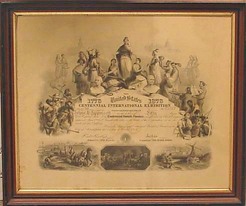One of my favorite things on Facebook is the Grandiloquent Word of the Day, although it tends to make me lament how dull language is these days. (Victorians in particular did lovely – and yes, sometimes torturous – things to language.) But every now and then, I do come across some relatively new colorful addition, like scripophily. This very modern word (1970s or so) means exactly what you’d think it means: a “phily” (love) of scrip, or tactlessly put, that paper that still isn’t worth anything. Except that sometimes it is!
Scripophily is a subset of numismatics and while factors like how the industry may have changed, the value of the stock, and, as always, the condition, may influence an auction estimate, scrip is typically desirable for three reasons: the historic context (like stock from the Portsmouth Whaling Company), the artwork – both subject and color (there are beautiful engravings on many stock certificates, especially those associated with the railroads), or the signatures (folks from Pat Garrett to Marcus Garvey to Harry Houdini put their autograph on scrip). Scripophily as a hobby has been growing since the 1970s, and while typically, the older the scrip, the greater the value, take heart – modern financial scandals and crises (think Enron) have given dollar value to stock certificates that might otherwise only be good for wallpapering the attic!




